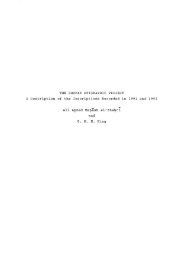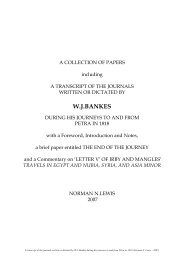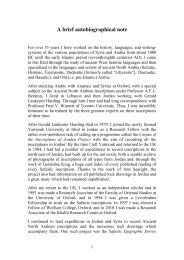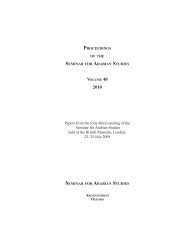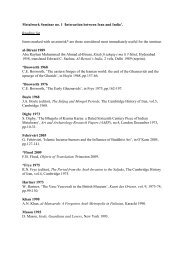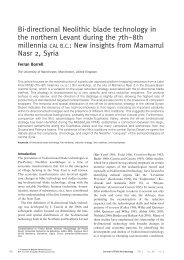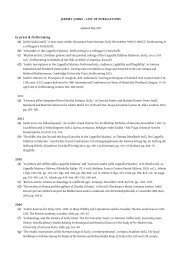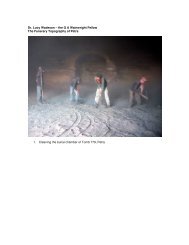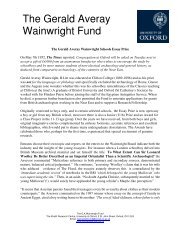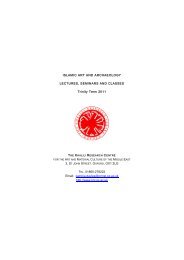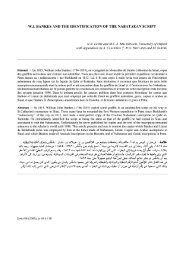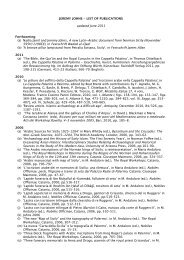Reflections on the linguistic map of pre-Islamic Arabia - Khalili ...
Reflections on the linguistic map of pre-Islamic Arabia - Khalili ...
Reflections on the linguistic map of pre-Islamic Arabia - Khalili ...
You also want an ePaper? Increase the reach of your titles
YUMPU automatically turns print PDFs into web optimized ePapers that Google loves.
c<strong>on</strong>tain elements which can be attributed<br />
to Old Arabic.<br />
[Sabaeo-Arabic]<br />
At <strong>pre</strong>sent, <strong>the</strong>re are no clear examples <strong>of</strong><br />
texts in <strong>the</strong> Sabaic script and language<br />
which c<strong>on</strong>tain elements clearly attributable<br />
to Old Arabic ra<strong>the</strong>r than ANA (173).<br />
However, when all <strong>the</strong> inscripti<strong>on</strong>s from<br />
Qaryat al-Faw are published it is very<br />
probable that some will be found to fall<br />
into this category.<br />
Safaeo-Arabic<br />
There are a handful <strong>of</strong> Safaitic inscripti<strong>on</strong>s<br />
which appear to c<strong>on</strong>tain <strong>the</strong> definite article<br />
$ l-. The clearest <strong>of</strong> <strong>the</strong>se is C 2446 which is<br />
known <strong>on</strong>ly from a hand-copy (Dn 68c).<br />
This reads<br />
lS 1c dbnMr $ bn Nr w-wgm c [l] $ h-h Nr<br />
qtl∞.±-h $ 1 (N)btw y mb c yn c m c wd w-dw f f-hlt<br />
m c mn w- $ lt dtn w-gd-[ c ](w)d w-gd-dw ft $ r<br />
m-d $ s 1 lf w-wlh kbr s 1 hw r c l $ h-h hw bb-h l- $ bd<br />
(174).<br />
‘By S 1c d s<strong>on</strong> <strong>of</strong> Mr $ s<strong>on</strong> <strong>of</strong> Nr and he<br />
mourned for his bro<strong>the</strong>r Nr (whom) <strong>the</strong> Nabataean<br />
killed during <strong>the</strong> attack (175) <strong>on</strong> <strong>the</strong><br />
flocks <strong>of</strong> c wd and Dw f (176). And so, O Lt<br />
m c mn (177) and goddess <strong>of</strong> Dtn (178) and<br />
Gd- c wd and Gd-Dw f (179) [grant <strong>the</strong> opportunity<br />
<strong>of</strong>] revenge <strong>on</strong> him who did this thing<br />
(180). And he mourned greatly s 1 hw r (181) for<br />
his bro<strong>the</strong>r, his beloved, for ever’.<br />
On Dunand’s copy, <strong>the</strong> first letter <strong>of</strong> (n)btw y<br />
is <strong>the</strong> same length as <strong>the</strong> <strong>pre</strong>vious l, asopposed<br />
to <strong>the</strong> very short ns in <strong>the</strong> rest <strong>of</strong> <strong>the</strong><br />
text, so <strong>the</strong> reading is not entirely secure.<br />
However, regardless <strong>of</strong> whe<strong>the</strong>r <strong>the</strong> nisba is<br />
Nbtw y or Lbtw y, it seems probable that <strong>the</strong> letters<br />
$ l re<strong>pre</strong>sent <strong>the</strong> Arabic article, ra<strong>the</strong>r<br />
than <strong>the</strong> word $ l (cf. Ar. $ āl) meaning ‘social<br />
group’, since in Safaitic this is always followed<br />
by <strong>the</strong> name itself ( $ lrm‘<strong>the</strong> people<br />
THE LINGUISTIC MAP OF PRE-ISLAMIC ARABIA<br />
<strong>of</strong> Rome, <strong>the</strong> Romans’, $ l dw f ‘<strong>the</strong> tribe <strong>of</strong><br />
Dw aif’, etc.) and never by <strong>the</strong> nisba (rmy, dw fy).<br />
Moreover, in Safaitic, ‘<strong>the</strong> Nabataeans’ are<br />
always called simply nbtw, ra<strong>the</strong>r than * $ l nbtw.<br />
If <strong>the</strong>refore, as seems likely, $ l in this c<strong>on</strong>text<br />
is <strong>the</strong> Arabic article, this text c<strong>on</strong>tains<br />
a record <strong>of</strong> what I have called <strong>the</strong> ‘nor<strong>the</strong>rn<br />
Old Arabic isogloss’ (182) in which <strong>the</strong> /l/<br />
<strong>of</strong> <strong>the</strong> article is not assimilated, even before<br />
<strong>the</strong> sounds called by <strong>the</strong> grammarians<br />
<strong>of</strong> Classical Arabic al-hw urūf al-sˇamsiyya or<br />
‘sun letters’.<br />
However, o<strong>the</strong>r features <strong>of</strong> <strong>the</strong> text are<br />
characteristic <strong>of</strong> Safaitic, such as <strong>the</strong> vocative<br />
particle h- and <strong>the</strong> assimilati<strong>on</strong> <strong>of</strong> <strong>the</strong><br />
n in <strong>the</strong> <strong>pre</strong>positi<strong>on</strong> mn. I would <strong>the</strong>refore<br />
place C 2446 am<strong>on</strong>g <strong>the</strong> ‘mixed texts’ as an<br />
example <strong>of</strong> ‘Safaeo-Arabic’.<br />
Ano<strong>the</strong>r possible text <strong>of</strong> this type is WH<br />
589 which c<strong>on</strong>tains <strong>the</strong> statement $ s 2 r∞.±q<br />
l-l-mdbr ‘and he migrated to <strong>the</strong> inner desert’.<br />
The two ls are clear <strong>on</strong> <strong>the</strong> photograph,<br />
but it is quite possible that <strong>the</strong>y are<br />
<strong>the</strong> result <strong>of</strong> dittography <strong>on</strong> <strong>the</strong> part <strong>of</strong> <strong>the</strong><br />
author, who had just written, and <strong>the</strong>n<br />
crossed out, a sec<strong>on</strong>d s 2 between <strong>the</strong> r and<br />
<strong>the</strong> q <strong>of</strong> $ s 2 rq. In Safaitic, <strong>the</strong> word mdbr is<br />
never used with <strong>the</strong> article (183), but it is<br />
possible that it was referred to as * $ l-mdbr<br />
in Old Arabic, cf. <strong>the</strong> place-name Rhw bt<br />
which also does not take <strong>the</strong> article in<br />
Safaitic, but appears as al-Ruhw bah in later<br />
Arabic (184).<br />
There are also several Safaitic inscripti<strong>on</strong>s<br />
in which <strong>the</strong> definite article appears<br />
as $ - ra<strong>the</strong>r than h-. Given that in <strong>the</strong><br />
Safaitic script <strong>the</strong> two letters are distinguished<br />
<strong>on</strong>ly by a short side-stroke (see<br />
Fig. 3), I restrict myself to those for which<br />
photographs are available and where it is<br />
difficult to suggest ano<strong>the</strong>r explanati<strong>on</strong><br />
(o<strong>the</strong>r than an error by <strong>the</strong> author). Thus<br />
SIJ 37 has s 1 lm w-fsw yt m-b $ s 1 $ -s 1 snt ‘security<br />
and deliverance from misfortune this year’<br />
(185), and KRS 125, an unpublished inscripti<strong>on</strong><br />
from nor<strong>the</strong>astern Jordan, has c wr<br />
51



